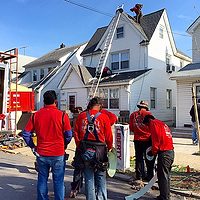Roofing Safety
A Roofing Contractor's Guide to Managing Heavy Loads on the Jobsite
With the right approach and tools, roofing contractors can manage the safety challenges posed by heavy workloads.

Handling heavy loads on roofing jobs demands precision and care. One wrong move can turn a routine task into a costly mistake or, worse, a life-threatening situation. This reality underscores the critical need for contractors to stay vigilant and well-prepared when managing materials at elevated heights.
The stakes are high. A single miscalculation can compromise the crew's safety and the structure's integrity. Yet, with the right approach and tools, these challenges can be managed effectively, turning potential hazards into a smooth, successful operation.
Understanding Weight Distribution
Roofing jobs are inherently risky and improper weight distribution is a common cause of accidents. When heavy materials are placed on a roof, the structure must be capable of supporting the load without compromising its integrity. A misjudgment here can lead to structural damage, which may not be immediately apparent but can worsen over time, potentially causing the roof to collapse.
Roofing contractors must begin by calculating the load capacity of the roof. This calculation should consider factors such as the type of roofing material, the structure's age, and the roof's current condition. Understanding these elements helps prevent overloading and evenly distribute the weight. Moreover, having a clear plan for where and how materials will be placed during the job can significantly reduce the risk of accidents.
Proper weight distribution isn’t just about safety. It's also about efficiency. A well-organized job site, where materials are placed strategically, can make the roofing process smoother and faster, leading to better results and fewer delays.
Training and Certification
Safety on roofing jobs doesn't just happen. It's the result of rigorous training and proper certification. Operating heavy machinery, such as cranes and forklifts, requires more than just familiarity. It demands a deep understanding of the equipment's capabilities and limitations. Proper training ensures that workers not only know how to use the machinery but also how to respond in emergencies.
Certification is equally crucial. It’s not just about complying with regulations—though important—it’s about ensuring everyone on the job site is qualified to handle the tools and equipment safely. For instance, those who become certified to operate a forklift gain the knowledge and skills needed to maneuver these machines with precision, reducing the risk of accidents and improving overall job efficiency.
Investing in ongoing training programs keeps skills sharp and ensures that everyone on the team is up-to-date with the latest safety protocols. It also fosters a culture of accountability, where every worker understands the importance of following procedures to protect themselves and their colleagues.
Selecting the Right Equipment for the Job
The success of any roofing job depends heavily on the equipment used, especially when handling heavy loads. Choosing the right tools can make the difference between a smooth operation and a hazardous work environment. Contractors must carefully select machinery and safety gear that suits the specific demands of the job.
Lifting and hoisting equipment are often indispensable, but their effectiveness hinges on proper usage. It's not only important to have the right tools, but also to know how to use them safely and effectively.
Equally important is ensuring all team members have the necessary safety gear. It protects them from potential hazards and fosters a safety culture on the job site. Here’s a list of essential safety equipment for roofing jobs:
- Hard Hats: Guard against head injuries and debris from above.
- Safety Harnesses: Provide fall protection when working at heights.
- Non-slip Footwear: Ensures stable footing on steep or wet surfaces.
- Gloves: Protect hands from sharp edges, splinters, and rough materials.
- Safety Glasses: Shield eyes from dust, debris, and harmful UV rays.
- Hearing Protection: Safeguards against prolonged exposure to loud machinery.
Proper Lifting Techniques
Incorrect handling can lead to injuries, equipment damage, or delays. To ensure safety, always secure and balance the load before hoisting, and never exceed the equipment's weight capacity. Operators must be trained and familiar with specific operating procedures.
Manual handling also requires attention. Use lifting straps to distribute weight evenly and protect the back, lift as a team when necessary, and always maintain proper posture by lifting with the legs. Before lifting, plan the route, ensuring it is clear of obstacles and stable. Safety gear like gloves and non-slip footwear adds another layer of protection, and regular equipment inspections are essential to maintaining safety standards.
Load Securing and Transportation on the Job Site
After lifting, securing and transporting heavy materials safely is crucial. Properly secured loads prevent shifting or falling during movement. Use tie-downs, straps, or netting for stability, especially for irregular loads.
When transporting, assess the terrain first. Uneven or slippery surfaces can increase risks. Use spotters in tight spaces, plan the route to avoid obstacles, and move slowly to keep the load secure.
The Impact of Weather
Weather is critical in roofing jobs, directly affecting safety and efficiency. High winds can make materials difficult to control, increasing the risk of accidents. Rain and snow create slippery surfaces, making it more likely for workers to slip or for materials to shift unexpectedly.
In hot weather, workers are at risk of heat exhaustion, while cold conditions can lead to numbness and decreased dexterity, making tasks more difficult and hazardous. Proper hydration, breaks in shaded areas, and appropriate clothing are essential to maintain safety in these conditions. Additionally, extreme cold can cause materials to become brittle, increasing the likelihood of breakage during handling.
It’s crucial to monitor weather forecasts and adjust work schedules accordingly to minimize these risks. When conditions are unfavorable, delaying the job or taking extra precautions can prevent accidents and ensure that both workers and materials remain safe.
Wrapping Up
Safety and efficiency are paramount in managing heavy loads on roofing jobs. Every step, from selecting the right equipment to responding to weather conditions, is crucial in protecting the crew and the structure. Contractors who prioritize proper training, equipment use, and risk mitigation strategies can confidently tackle these demanding tasks. By staying proactive and prepared, they ensure the success of the project and the well-being of everyone involved.
Looking for a reprint of this article?
From high-res PDFs to custom plaques, order your copy today!





